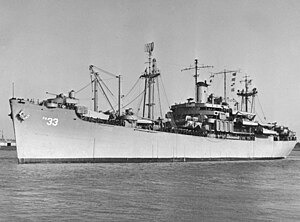 USS Bayfield (APA-33) on 4 January 1950
| |
| Class overview | |
|---|---|
| Name | Bayfield |
| Builders | |
| Operators | |
| Preceded by | Ormsby class |
| Succeeded by | Sumter class |
| In commission | 1943–1945 – 1946–1970 |
| Completed | 34 |
| Active | None |
| General characteristics | |
| Type | Attack transport |
| Displacement | 8,100 tons, 16,100 fully loaded |
| Length | 492 ft 6 in (150.11 m) |
| Beam | 69 ft 6 in (21.18 m) |
| Draft | 26 ft 6 in (8.08 m) |
| Propulsion | Geared turbine drive,[1] 2 × D-type boilers,[2] single propeller, designed shaft horsepower 8,500 |
| Speed | 18 knots (33 km/h; 21 mph) |
| Boats & landing craft carried | |
| Capacity |
|
| Complement |
|
| Armament |
|
The Bayfield-class attack transport was a class of US Navy attack transports that were built during World War II.
With the entry of the United States into the war, it was quickly realized that amphibious combat operations on hostile shores would be required, and that specialized ships would be needed for the purpose. The so-called "attack transport" ship type (hull classification symbol APA) was developed to meet this need. Attack transports were converted from standard transport vessels by being upgraded with extra firepower, and outfitted with a number of smaller integral landing craft (such as LCVPs and LCMs) with which amphibious assaults could be conducted.
The first attack transports began to enter service in 1942 and were built ad hoc from a host of different types. The first class to be built in substantial numbers was the Bayfield class, which began to enter service in 1943. The early vessels were converted from existing cargo or transport ships, later ones built as attack transports from the keel up.
- ^ Built by either General Electric or Westinghouse.
- ^ Built by Combustion Engineering, Foster Wheeler or Babcock & Wilcox.